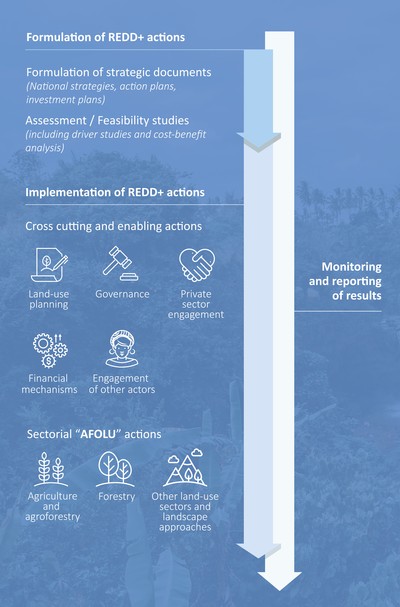REDD+ implementation
Building on the initial REDD+ preparatory phase, an increasing number of countries are in the advanced stages in their REDD+ readiness efforts and are moving towards implementation of REDD+ activities to achieve emissions reductions and access results-based payments (RBPs). In parallel, numerous donors and initiatives are coming forward to support these countries in planning and implementing REDD+ mitigation actions, which are key to achieving REDD+ targets.
Across the three geographic regions (Asia Pacific, Africa, Latin America and the Caribbean), countries are requesting FAO’s technical support on REDD+ implementation, covering:
- Formulation of REDD+ actions;
- Implementation of REDD+ actions, including enabling actions;
- Monitoring and reporting of results of REDD+ actions.
While this specific webpage focuses on formulation and implementation of REDD+ mitigation actions, additional information on FAO work on REDD+ monitoring and reporting and on FREL can be found on the specific pages.
These REDD+ actions refer to the necessary steps by countries to reduce greenhouse gas (GHG) emissions under the UNFCCC. Specifically: "parties shall adopt national policies and take corresponding measures on the mitigation of climate change, by limiting its anthropogenic emissions of greenhouse gases and protecting and enhancing its greenhouse gas sinks and reservoirs” (article 4.2(a) UNFCCC).
Through REDD+, these actions include legal and/or policy instruments added to other actions that REDD+ countries put in place to support the deployment of their REDD+ activities. REDD+ actions often have the potential to contribute to several REDD+ activities, and may apply to different land-use sectors in addition to the forests sector.
REDD+ actions are generally categorized into two broad types – policies and measures – but the lines between these types can be blurred. The term ‘policies’ refers to actions related to the enabling environment of REDD+ activities, while the term ‘measures’ refers to actions that are linked to field implementation.
REDD+ actions are highly country-specific and will likely evolve with practice. FAO is supporting countries in planning and implementing REDD+ actions (particularly those reflected in INDC/NDCs), recognizing:
- the importance of integrated landscape approaches, including all sectors and land-uses;
- the critical role of all national stakeholders, particularly indigenous peoples and local communities, as well as private sector actors, including forest and farm smallholders. In fact, local communities and smallholders manage large territories around the world, so it is essential that they are effectively engaged, recognised and supported in REDD+ planning an implementation to ensure the desired reduction and avoidance of forest carbon emissions;
- gender equality and women’s empowerment as a catalyst for enhancing the effectiveness, efficiency and sustainability of REDD+;
- sustainable forest management (SFM) as the framework for forest actions, as reflected in FAO's SFM toolbox; and
- the need to look beyond REDD+ when identifying and implementing mitigation actions, so as to recognise the multiple functions of forests and promote mitigation-adaptation co-benefits.
In the context of REDD+, mitigation actions can often involve the policies and measures (PAMs) referred to by the UNFCCC and including such legal and policy instruments as:
- updated regulations, tenure rights, subsidies, incentives, transparency, law enforcement
- field implementation actions such as land-use planning, sustainable forestry and agriculture practices, support to alternative livelihoods, forest restoration
- national strategies, investment plans, studies of drivers of climate change
- carbon rights and benefits sharing
Thematic readings "From REDD+ Readiness to Implementation and Results: FAO’s support to countries"

Under the common theme “From REDD+ Readiness to Implementation and Results: FAO’s support to countries”, a set of flyers was recently published by FAO. The flyers aim to facilitate countries’ reflection and decision-making on how to plan and implement actions to reduce emissions from deforestation and forest degradation:
- REDD+ actions overview
- Land-use planning for REDD+
- Land and forest tenure reform to support REDD+ implementation
- Forest governance and timber legality for REDD+
- The role of local communities, smallholders, and indigenous peoples in REDD+ implementation
- Private sector engagement in REDD+ actions
- REDD+ finance and investments
Additional thematic readings on other REDD+ actions, will be released in the forthcoming months, to cover the multiple mitigation options that countries may implement to achieve their climate change targets.


